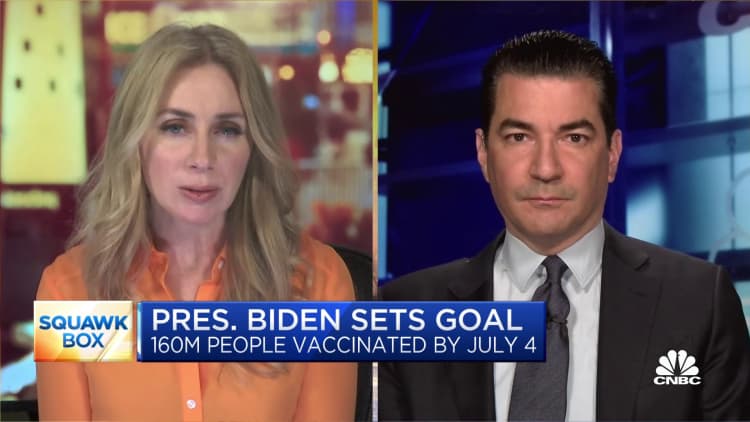
Covid-19 cases will likely surge again in the U.S. as the highly contagious B.1.1.7 variant takes hold across the country, peaking in May before sharply declining by July, according to new data released Wednesday from the Centers for Disease Control and Prevention.
The rise in Covid cases is expected as states relax pandemic prevention strategies for businesses, large-scale gatherings and schools, and the B.1.1.7 variant, first identified in the U.K., spreads more rapidly throughout the country, the CDC said in the report.
The agency projected the trajectory of the pandemic based on four different scenarios of vaccination rates and state reopenings. While the case numbers differed in each scenario, the general direction of the outbreak remained mostly the same in all four forecasts with cases surging in May before falling in July.
While Covid cases are expected to increase this month, hospitalizations and deaths will likely remain low nationally, the U.S. agency said, with cases expected to plummet by July as more Americans get vaccinated against the virus.
High vaccination coverage and compliance with pandemic safety measures "are essential to control COVID-19 and prevent surges in hospitalizations and deaths in the coming months," federal health officials wrote in the report.
During a White House Covid press briefing later Wednesday, CDC Director Dr. Rochelle Walensky said the projections should remind Americans "we have a path out of this."
"Although we are seeing progress in terms of decreased cases, hospitalizations and death, variants are a wild card that could reverse this progress we have made," she said. "We are seeing that our current vaccines are protecting against the contaminant variants circulating in the country. Simply put, the sooner we get more and more people vaccinated, the sooner we will all get back to normal."

The rate of daily new infections fell below 50,000 per day over the weekend and continues to decline, according to Johns Hopkins University data, as the latest seven-day average stands at 48,100 cases per day.
The new data comes just ahead of the Memorial Day and Fourth of July holidays. President Joe Biden has said he hopes to see enough Americans vaccinated by Independence Day to safely hold small outdoor gatherings.
On Tuesday, Biden announced his administration's latest goals in the fight against the coronavirus: getting 70% of U.S. adults to receive at least one dose of a Covid vaccine and having 160 million adults fully vaccinated by July 4.
As of Tuesday, more than 145 million Americans age 18 and older, or 56.4% of the total adult population, have received at least one dose of a Covid-19 vaccine, according to data compiled by the CDC. More than 105 million Americans age 18 and older, or 40.8% of the total adult population, are fully vaccinated, according to the CDC.
In recent weeks, the pace of individuals receiving their first vaccine doses has fallen, though U.S. health officials say they are working to improve access to the shots as well as encourage more hesitant Americans to get vaccinated.
The CDC used data from the COVID-19 Scenario Modeling Hub, which developed six models to assess the potential course of Covid-19 in the U.S. across four scenarios. Researchers took into consideration vaccination rates and the implementation of policies such as mask-wearing and social distancing.
Additionally, the projections were based on data through late March, when Covid cases were on the rebound.
– CNBC's Nate Rattner contributed to this report.


